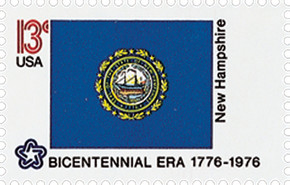
U.S. 1656
1976 Maine
State Flags
American Bicentennial Series
• First time a sheet 50 had all different stamp designs
• Part of the American Bicentennial Series
Stamp Category: Commemorative
Series: American Bicentennial Series
Value: 13¢ First-class postage rate
First Day of Issue: February 23, 1976
First Day City(s): Washington, DC
Quantity Issued: 8,720,100 (panes of 50)
Printed by: Bureau of Engraving and Printing
Printing Method: Photogravure
Format: Sheet of 50
Perforations: 11
Why the stamp was issued:
The United States Postal Service celebrated the American Bicentennial with a full pane of the Union’s fifty state flags.
About the stamp design:
Missouri was once the Gateway to the West, a port in the nation's heartland, and was known as a launching point for westward expansion.
Lewis and Clark were among the first to journey west from Missouri. Traveling along the Missouri River, they encountered numerous grizzly bears and were the first to document the species.
Traveling on the Missouri River, mountain men and settlers followed their routes to the Pacific Northwest. When gold was discovered in California, prospectors and adventurers flocked to Missouri, where steamboats took them to the Santa Fe Trail. River traffic increased so much during this time that St. Louis became the second-largest port in the country.
In 1908, the Missouri chapter of the Daughters of the American Revolution realized that Missouri had no state flag. They formed a committee to design the official flag of Missouri. Committee chairwoman Marie Oliver eventually designed the flag herself, centering the state seal on a field of red, white, and blue. On either side of the Missouri seal, harkening back to the days of Lewis and Clark, are two huge grizzly bears.
About the printing process:
Printed by the Bureau of Engraving and Printing on their seven-color Andreotti gravure press (601) which was their work horse for multicolored stamps.
About the American Bicentennial Series:
In the 1970s, America celebrated its 200th anniversary with hundreds of national events commemorating the heroes and historic events that led to our nation’s independence from Great Britain. The U.S. Postal Service issued 113 commemorative stamps over a six-year period in honor of the U.S. bicentennial, beginning with the American Revolution Bicentennial Commission Emblem stamp (U.S. #1432). As a group, the Bicentennial Series chronicles one of our nation’s most important chapters, and remembers the events and patriots who made the U.S. a world model for liberty.
Several of the stamps honored colonial life – craftsmen and communication. Other stamps honored important battles including Lexington and Concord, Bunker Hill, and Saratoga. Significant events such as the Boston Tea Party, the meeting of the First Continental Congress, and the Declaration of Independence were featured as well. The stamps also honored many significant people such as George Washington, Sybil Ludington, Salem Poor, and the Marquis de Lafayette.
Many of the stamps feature classic artwork. For instance, the set of four souvenir sheets picture important events recreated by noted artists such as John Trumbull. The Bicentennial Series also includes an important US postal first – the first 50-stamp se-tenant – featuring all 50 state flags. The format proved to be popular with collectors, and has been repeated many times since.
The American Bicentennial Series is packed with important US history – it tells the story of our nation’s fight for independence through stamps.
History the stamp represents:
On August 10, 1821, President James Monroe signed legislation adding Missouri to the Union as our 24th state.
Long before Europeans came to Missouri, a group of Indians known as the Mound Builders constructed large earthworks throughout the region. Many of these mounds can still be found there. However, this culture had disappeared by the time of European exploration.
The first European explorers in Missouri found Missouri Indians living in the east-central portion of the state, the Osage in the south and west, and the Fox, Sauk and other tribes living in the north.
The French explorers Father Jacques Marquette and Louis Jolliet were probably the first white people to see the mouth of the Missouri River. In 1673, they discovered the point where the Missouri joins the mighty Mississippi River. René-Robert Cavelier, Sieur de La Salle, sailed down the Mississippi in 1682 and claimed the entire river valley for France. He named it Louisiana, in honor of King Louis XIV.
Soon after, Frenchmen involved with the fur-trading business began to settle in the region, founding trading posts along the river. Around 1700, Jesuit missionaries founded the first European settlement in Missouri, the Mission of St. Francis Xavier, near today’s St. Louis. This mission was abandoned three years later due to its proximity to an unhealthful swamp. Settlers from what is now Illinois founded the first permanent white settlement at Ste. Genevieve. In 1764, Pierre Laclède Liguest and René Auguste Chouteau founded St. Louis.
In 1762, France sold to Spain all of its land west of the Mississippi. Spain encouraged many settlers in the East to take land in Missouri. Among these pioneers was the legendary Daniel Boone. In 1800, Napoleon Bonaparte of France forced Spain to give these lands back to France. Then, to raise badly needed funds, Napoleon sold the Louisiana Territory to the United States in 1803.
Missouri first asked to be granted statehood in 1818. At that time, the country was becoming divided by the practice of slavery and its expansion into new territories. These disputes delayed Missouri’s statehood until Congress passed the Missouri Compromise. Under this law, Missouri entered the Union as a slave state on August 10, 1821.















